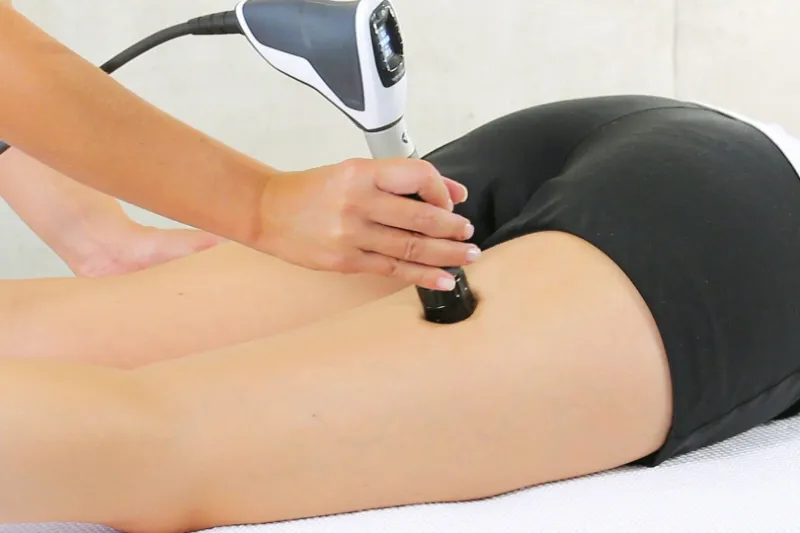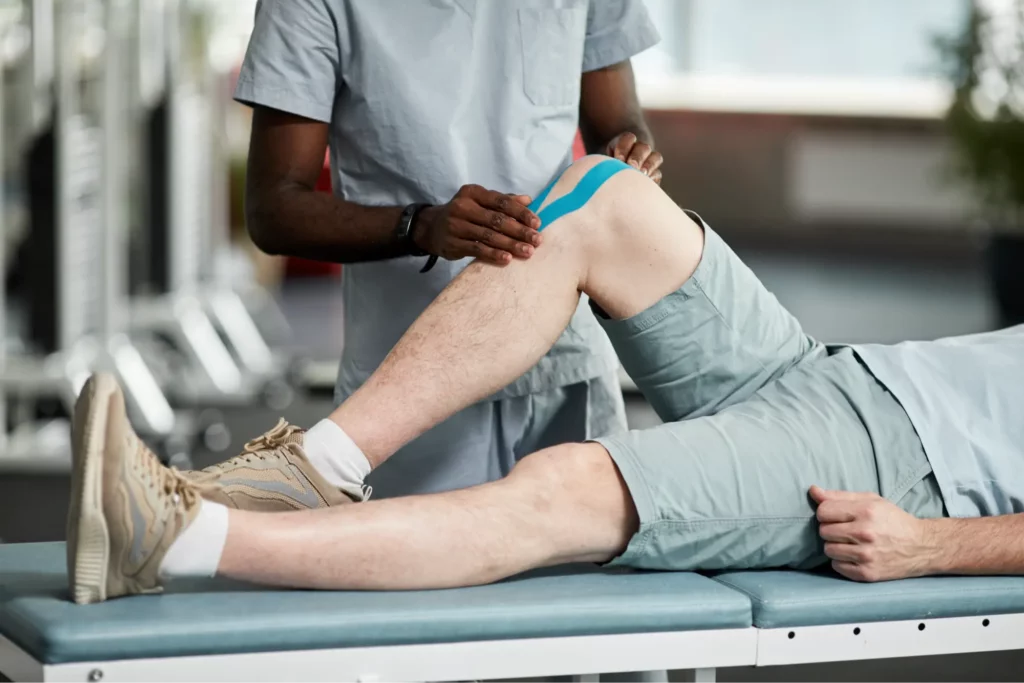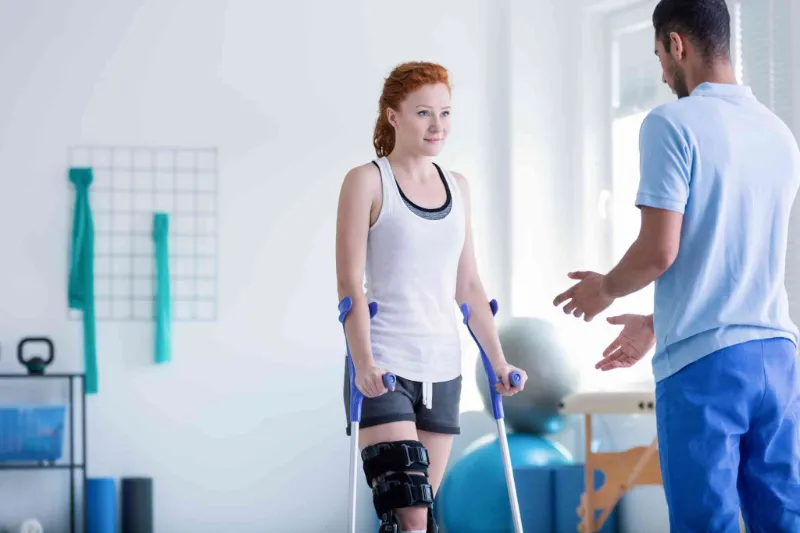Shockwave (ESWT) Therapy

Shockwave Therapy
Not as bad as it sounds. Shockwave Therapy is used to treat chronic tendon problems, in conjunction with an exercise program. This is effective for various tendon problems and is performed by our highly trained team.

What is it?
Shockwave was developed from Lithotripsy in the 1950’s, originally designed to treat kidney stones. The developers realised that as well as dissolving the kidney stones, shockwave therapy seemed to help with certain musculoskeletal conditions. With advances in the equipment and plenty of research, shockwave is now available as a treatment for various common conditions such as:
- Planar fasciitis
- Patella tendinitis
- Achilles tendinitis
- Greater trochanteric (glueal) tendinitis
- Tennis elbow
- And more….
Shockwave (ESWT) Therapy
- Our therapists have undergone further training in the safe use of shockwave therapy and can provide this as part of a rehabilitation program for troublesome tendons. We may recommend that you undergo further imaging to confirm your diagnosis before using shockwave, unless this has been performed already. In some cases, the history is very obvious and further assessment is not required.
- Shockwave is available to both insured and self-funding patients and is typically performed over a course of approx. 6 sessions alongside an exercise rehabilitation program designed to strengthen the relevant area. Results may be seen during the treatment timeframe but are more commonly later down the line, hence we will complete the shockwave treatment and then recommend to follow up with you further to track and further manage your recovery.

What is Shockwave Therapy?
Shockwave therapy, also known as Extracorporeal Shock Wave Therapy (ESWT), is a clinically proven and highly effective treatment for chronic tendon injuries and certain bone conditions.
An extracorporeal shockwave is a non-invasive, non-electrical high energy sound impulse that passes into the body via a hand-held probe.
The shockwaves create an increase in inflammation and blood flow to the target area and can break down fibrous scar tissue which builds up over time, especially with chronic conditions. This helps to stimulate cell regeneration and promote tissue healing resulting in improved pain and function.
Shockwave is best utilised alongside a comprehensive rehabilitation programme that typically begins once the shockwave treatment is completed.
Shockwave therapy can be effective on a wide range of chronic tendon problems. Here are some examples of conditions where shockwave has been shown to effectively treat symptoms and improve function:
- Plantar fasciitis (medial arch pain)
- Lateral Epicondylitis (Tennis Elbow)
- Patellar tendinitis (jumper‘s knee)
- Achilles tendinitis (heel pain)
- Greater Trochanteric Pain Syndrome (lateral hip pain)
- Proximal hamstring tendinitis
Your physiotherapist will work with you to identify the exact area of pain and apply a gel to the area to allow the Shockwave to be delivered effectively. A probe is pressed on to the affected area and the Shockwaves are delivered through the skin.
The impulses are delivered through the skin as a Shockwave that spreads inside the injured tissue as an aspherical ‘radial’ wave. These radial Shockwaves initiate an inflammation-like response in the injured tissue that is being treated, and prompts the body to respond naturally by increasing blood circulation, the number of blood vessels and therefore metabolism in the injured tissue.
The Shockwaves are felt as pulses which can be uncomfortable but should not be acutely painful. Typically your first treatment will start with a low level of intensity and increase this to a point where you feel comfortable.
Shockwave therapy treatments are usually performed at weekly intervals and the best evidence available recommends 3-5 treatments followed by a 2-3 month period of progressive strengthening.
This does somewhat depend on the area being treated but research has demonstrated that, in the lower limb, approximately 80% of patients report a reduction of pain and improvement in function.
Research is steadily growing for this cutting-edge technology and the latest reports are confirming shockwave therapy is an effective treatment of chronic tendon injuries and certain bony conditions like heel spurs and calcific rotator cuff tendinitis.
Shockwave is also now recommended by NICE for the treatment of chronic tendon conditions especially of the lower limbs alongside a progressive strengthening programme.
What Are The Side Effects And Exclusion Criteria?
The physiotherapist providing the treatment will have checked your medical history to ensure that you are at minimal risk of any side effects.
Most Common:
- Redness or bruising in the treated area
- Skin damage
- An increase in pain in the treated area, this can be controlled with paracetamol, please do not take NSAIDs e.g. ibuprofen, naproxen.
Very Rare:
- Tendon rupture
- Nerve irritation/damage
Exclusion Criteria/Contraindications:
- Steroid injection in the past 60 days
- Tendency to haemorrhage
- Patients taking anti-coagulant therapy
- Haemophiliac patients
- Acute inflammation of the treatment area
- Tumour or infection at the treatment site
- Pregnancy
- Severe circulatory disorder
- Nerve disorder at treatment site
- Open wound at the treatment site
- Prosthesis( ie. hip replacement)
Many patients experience an improvement in symptoms almost immediately while others take several weeks to respond. You may notice a reddening or swelling of the area with some patients experiencing a brief increase in pain. Is likely to take several weeks to see an overall benefit alongside your progressive strengthening plan.
Following Shockwave therapy maintain your “normal” levels of activity but do not do anything you normally would not do. Avoid sports, running, jumping and hopping and any other aggravating activities which may stress the treated area for the next 48 hours. Your physio will give you individual advice as required.
Do not use ice on the treated area or take non-steroidal anti-inflammatory medicines e.g. ibuprofen, naproxen as these may reduce the therapeutic effect of ESWT.
See why patients love Raynes Park Physio

"Cannot recommend the clinic highly enough. Nick treated my daughter after knee surgery. Hugely thorough, knowledgeable and caring. There are physio teams and physio teams.... This is the best I've experienced in years."
Andrew Willmott

"Nick helped me after I started experiencing pain in my hip/leg from weightlifting. He not only identified and guided me through fixing the problem, but has also given me a great deal of valuable advice for my training. Very happy with the results, would definitely recommend."
Kim Wilson

This is probably the best physio practice I've been to. I've been to other 'professional' physios that provide treatment for the sake of appearing to do something. The first session is generally a consultation to examine the issues. The ongoing advice and treatment is fantastic."
Stacy Walter
Insurance
We accept payment from major insurers, if your insurance company isn’t shown below please contact us to discuss options, we may still be able to help!
